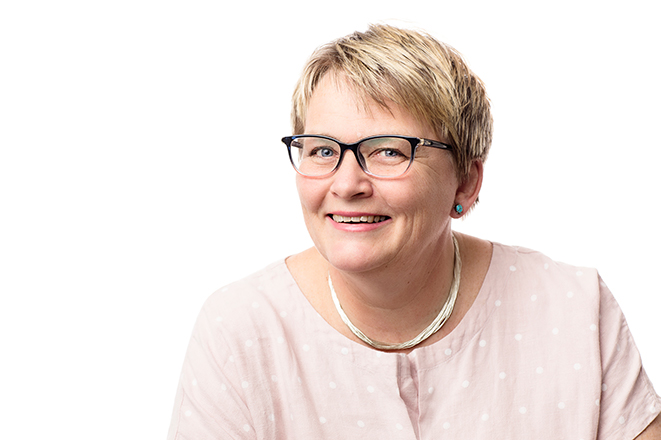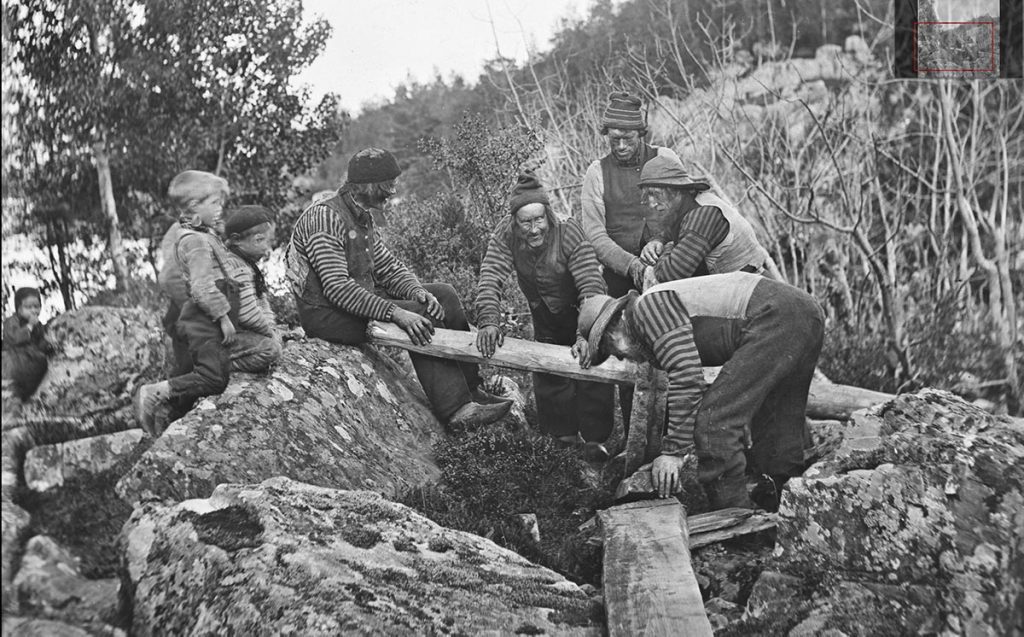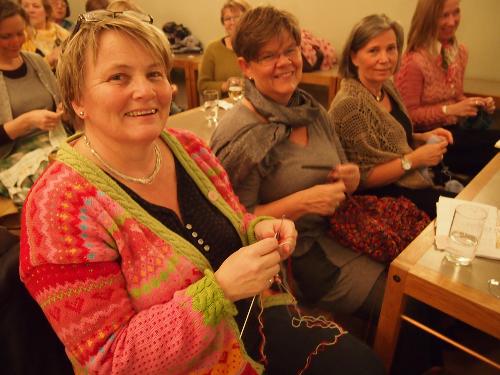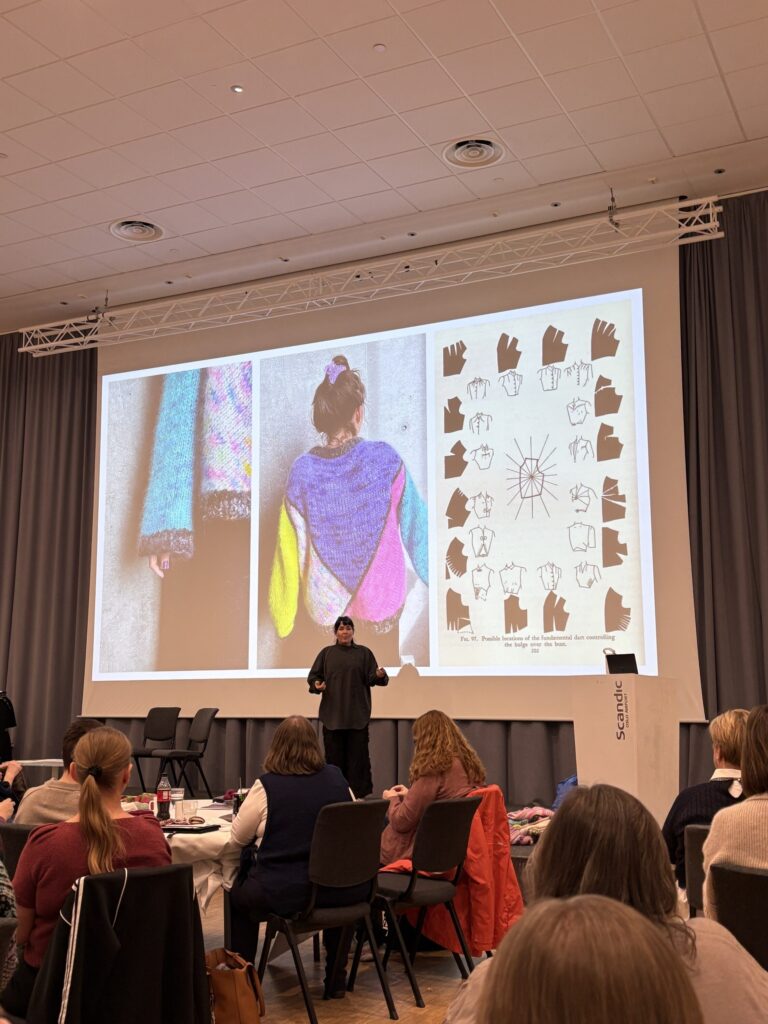 For the second time around the NSF/Norwegian Knitting Association’s annual knitting weekend was held at Scandic Oslo Airport Hotel at Gardermoen, the first weekend in March. Continue reading
For the second time around the NSF/Norwegian Knitting Association’s annual knitting weekend was held at Scandic Oslo Airport Hotel at Gardermoen, the first weekend in March. Continue reading
Tag Archives: Nina Granlund Sæther
Norske Strikketradisjoner/Norwegian Knitting Traditions
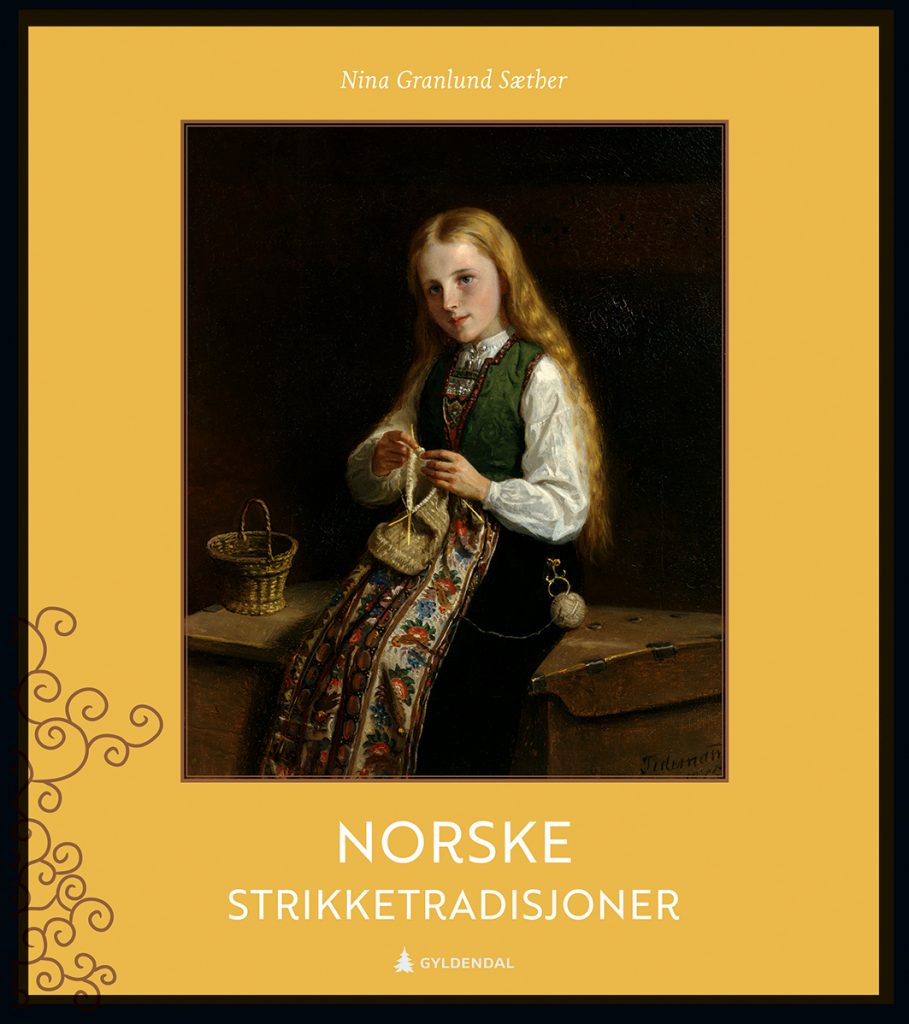 “Norske strikketradisjoner” is the title of Nina Granlund Sæther’s astonishing book, published by Gyldendal last autumn. Nina has dived down into history hunting for traces on how the knitting technique came to Norway, spread and became part of our national history and identity. She documents with text, numerous photos and textiles how Norwegians have dressed with layers of knitted garments from underwear to outerwear. Even back in 1865 the theologist and sociologist Eilert Sundt pointed out that the technique was useful for the poor and comfortable for the nobles, as well as equally relevant for young and old people.
“Norske strikketradisjoner” is the title of Nina Granlund Sæther’s astonishing book, published by Gyldendal last autumn. Nina has dived down into history hunting for traces on how the knitting technique came to Norway, spread and became part of our national history and identity. She documents with text, numerous photos and textiles how Norwegians have dressed with layers of knitted garments from underwear to outerwear. Even back in 1865 the theologist and sociologist Eilert Sundt pointed out that the technique was useful for the poor and comfortable for the nobles, as well as equally relevant for young and old people.
From the foreword, I have chosen three paragraphs that I have translated into English: “Textiles have always fascinated me. I learnt to knit before the age of five, and every since I have embraced everything related to knitting – whether it was new patterns and colourful yarns, or the story about a mitten or a pair of kneelength stockings for men with holes. When I at the beginning of 2016 said yes to writing this book, I had no idea what I let me self in for. I thought it would take me one year or so. Well, it was not that easy! The more I discovered, the more sources I found, the more I learnt hence I became even more eager to find more, diving even deeper into the material. This takes time. But oh my, how educational and fun it has been!”
“Many believes that the vikings could knit, but they could only do needle-binding. When you work needle-binding, you sew loops into each other. Hence you have to piece together lengths of yarn instead of using a continuous strand of yarn and that takes a lot more time. The knitting history is surprisingly short. In our own country [Norway] the technique has been known for barely 400 years”.
“I have looked for traces in literature – in everything from large acknowledged printed matters to less known, local historical articles. I have searched for dissertations from universities and colleges, and I have googled for church books and census online. I have flickered through hundreds of index cards and studied thousands of photos, both paintings and photographs. I have also visited museums and exhibitions all over Norway. Sometimes I have even been treasure hunting in museum storages. Hence even the garments themselves have been able to tell their story. Last, but not least, I have met a number of people who have had histories to tell or garments to show off.”
Here is one example; it shows stripy sweaters. You can see eight other photos from the book here: puff.gyldendal.no and inside the book here: Norske strikketradisjoner.
Now why stripes? Nina explains: “Over large parts of Europe seamen wore stripes during the 1800-century. Several artists have documented that stripy sweaters were in ordinary use all over Norway through the 1800-century. From Tysnesøen south of Bergen and Os there exists a number of pictures of stripy sweaters taken by the photo pioneer Knud Knudsen. «Parti fra Tysnesøen» is dated 1865-1875 and shows a group of five men and two boys, in addition to a small child who has sneaked in into the background”. She continues to tell us about the small differences in them and how they are made. See more here: here: puff.gyldendal.no.
All the hundreds of photos in this book with its histories make it a treasure trove but also unlikely to be translated due to the cost of the photo rights. However the Norwegian edition is a treasure for anybody interested in knitting and its history.
I bought my copy directly from Nina, when we were both teaching at the Strikkehelg/Knitting Weekend at Geilo, but you can buy the Norwegian book directly from the publisher Gyldendal or selected book stores in Norway.
Book Launches at Cappelen Damm
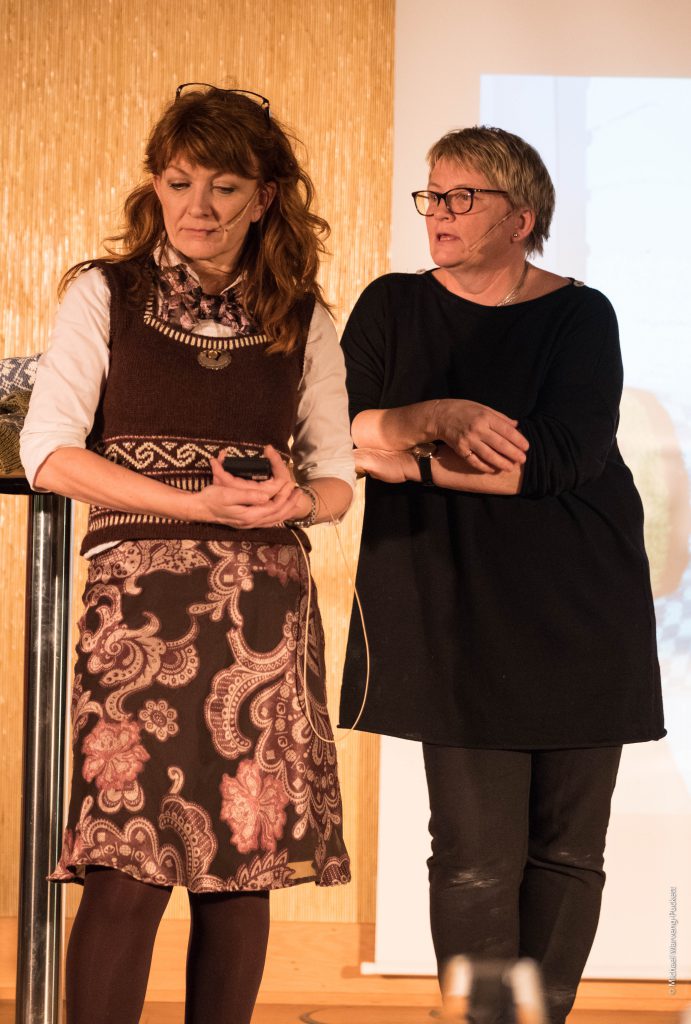 Last Wednesday my husband and I attended a knitting evening at the Norwegian publishing house Cappelen Damm in Oslo. We knew the authors and their photographers: Helle Siggerud (left), was publishing her first knitting book called “Strikk til alle tider“/Knitwear for all occasions, while Nina Granlund Sæther was publishing her 10th book called “Sokker fra hele Norge“/Socks from Around Norway. Both books are beautifully photographed: Helle’s by no other than Eivind Røhne and Nina’s by Guri Pfeifer. Both authors have travelled around Norway visiting museums and studying local traditions. They did bump into each other at a carpark at a small museum in Telemark late one afternoon. Both talented designers held a talk; Helle on the costume traditions she discovered on her trip and Nina on the history of stockings going all the way back to the Egyptians. We were offered sparkling wine, the opportunity to study their sample projects, buy books at a discounted rate, take part in the raffle as well as ask our questions. Some of the women present were knitting, but I could only focus on their talks and gladly gave up my attempt.
Last Wednesday my husband and I attended a knitting evening at the Norwegian publishing house Cappelen Damm in Oslo. We knew the authors and their photographers: Helle Siggerud (left), was publishing her first knitting book called “Strikk til alle tider“/Knitwear for all occasions, while Nina Granlund Sæther was publishing her 10th book called “Sokker fra hele Norge“/Socks from Around Norway. Both books are beautifully photographed: Helle’s by no other than Eivind Røhne and Nina’s by Guri Pfeifer. Both authors have travelled around Norway visiting museums and studying local traditions. They did bump into each other at a carpark at a small museum in Telemark late one afternoon. Both talented designers held a talk; Helle on the costume traditions she discovered on her trip and Nina on the history of stockings going all the way back to the Egyptians. We were offered sparkling wine, the opportunity to study their sample projects, buy books at a discounted rate, take part in the raffle as well as ask our questions. Some of the women present were knitting, but I could only focus on their talks and gladly gave up my attempt.
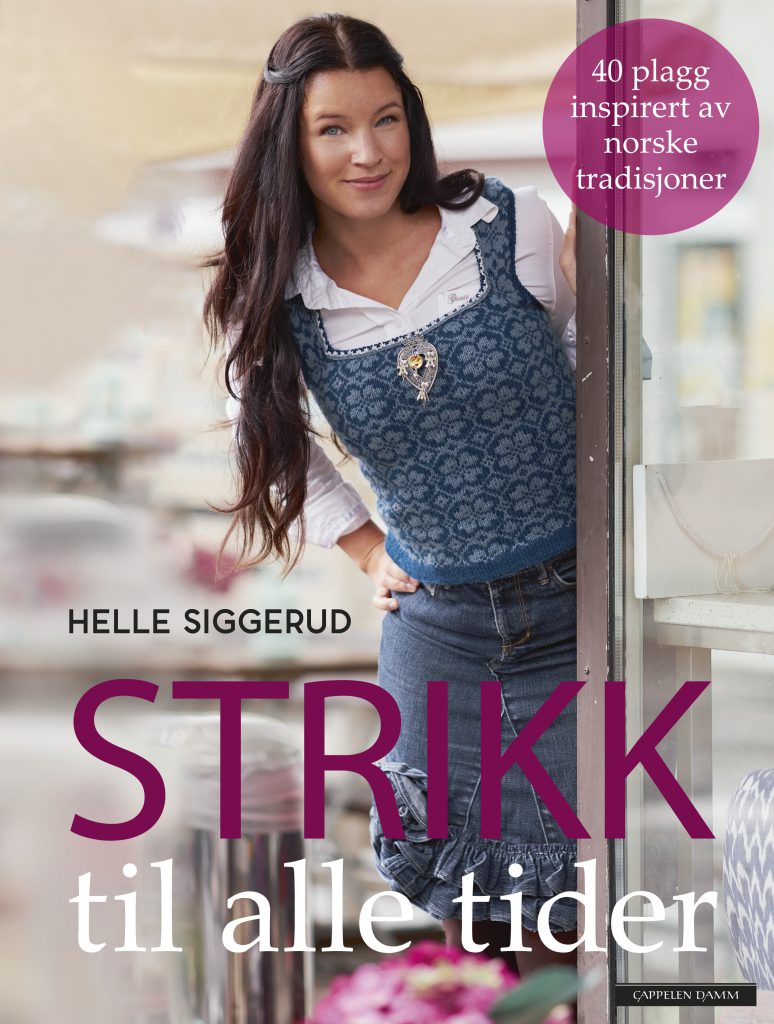 Helle’s book is published in Norwegian, but the Cappelen Damm Agency presents the book as follows in English in order to sell the foreign rights: “40 garments inspired by Norwegian traditions In this wonderful knitting book, Helle Siggerud has been inspired by costume traditions and folklore from all over Norway. She has traveled far and wide and immersed herself in Norwegian patterns; used in knitting, weaving, embroidery and wallpaper; and has transformed it into beautiful knitwear. Helle is famous for her figure-hugging garments, good cuts and snappy details. And you’ll find all that here. The book features mostly women’s garments, but there are also great designs for men and children – and for dogs!”
Helle’s book is published in Norwegian, but the Cappelen Damm Agency presents the book as follows in English in order to sell the foreign rights: “40 garments inspired by Norwegian traditions In this wonderful knitting book, Helle Siggerud has been inspired by costume traditions and folklore from all over Norway. She has traveled far and wide and immersed herself in Norwegian patterns; used in knitting, weaving, embroidery and wallpaper; and has transformed it into beautiful knitwear. Helle is famous for her figure-hugging garments, good cuts and snappy details. And you’ll find all that here. The book features mostly women’s garments, but there are also great designs for men and children – and for dogs!”
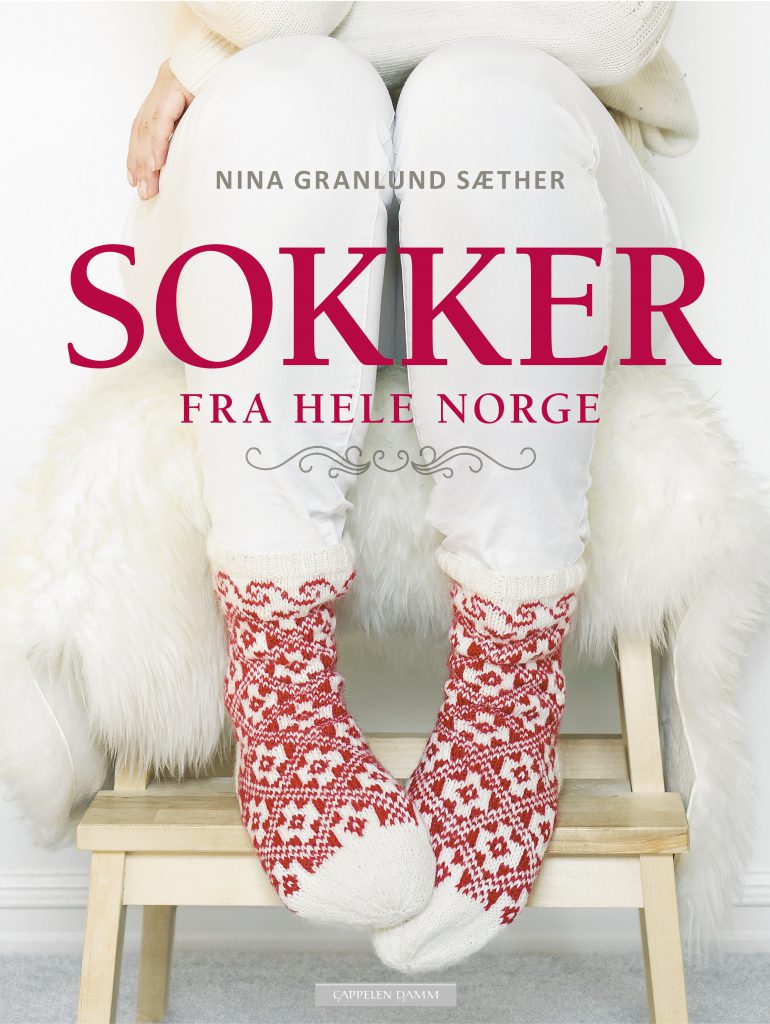 Nina’s previous book “Votter fra hele Norge”/Mittens from Around Norway is in its 5th edition in Norwegian and has sold more than 31 000 books so far. The English translation has been reviewed in magazines abroad as well as promoted by the library in New York in the US. Here is an introduction to her latest book from the Cappelen Damm Agency pages: “Nina Granlund Sæther is back, this time with the follow-up to her best seller Mittens. In Socks From Norway, we travel once again through Norway’s countryside and it’s knitting traditions – this time while keeping our feet warm. In this book you’ll find fascinating stories about the origins of the various socks, archive images from museums around the country, and plenty of instructions for socks for the whole family.” I believe it is only a question of time before these books are translated into English.
Nina’s previous book “Votter fra hele Norge”/Mittens from Around Norway is in its 5th edition in Norwegian and has sold more than 31 000 books so far. The English translation has been reviewed in magazines abroad as well as promoted by the library in New York in the US. Here is an introduction to her latest book from the Cappelen Damm Agency pages: “Nina Granlund Sæther is back, this time with the follow-up to her best seller Mittens. In Socks From Norway, we travel once again through Norway’s countryside and it’s knitting traditions – this time while keeping our feet warm. In this book you’ll find fascinating stories about the origins of the various socks, archive images from museums around the country, and plenty of instructions for socks for the whole family.” I believe it is only a question of time before these books are translated into English.
SaveSaveSaveSave
Strikkefestivalen in Fredrikstad
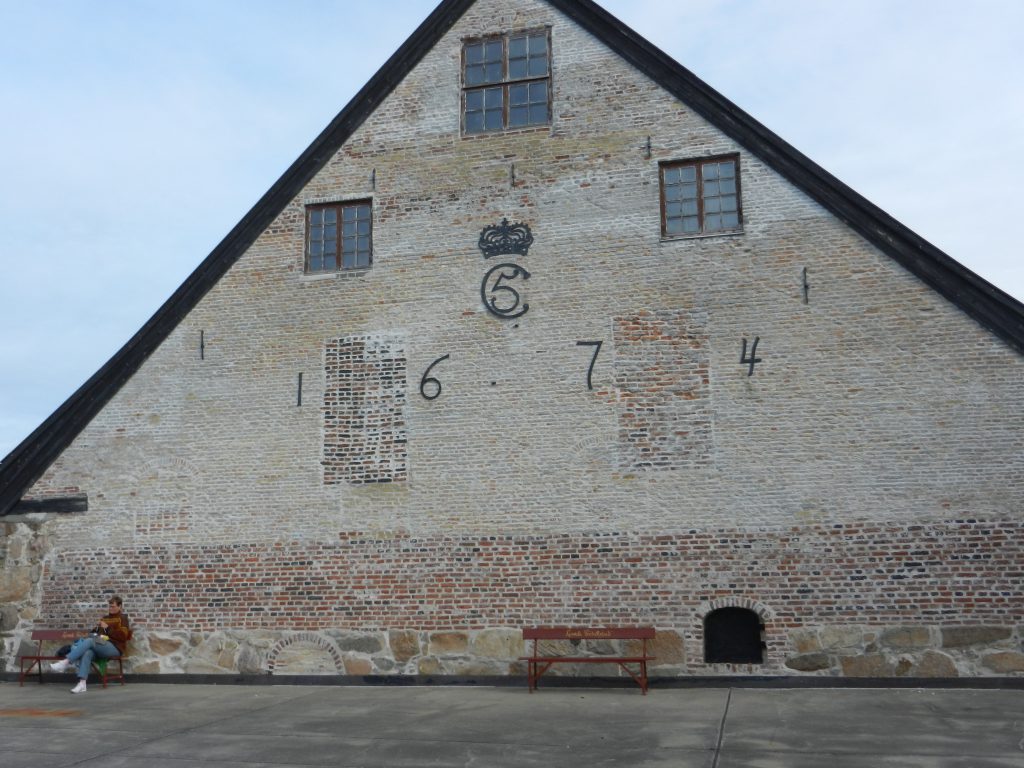 For the first time there was a Strikkefestival in Fredrikstad. Of course the organizers – or knitting motors as they called themselves – Marit Larsen, Bente Vold Klausen and Torill Stokkan, choose the old town by the river Glomma as the location. Fredrikstad Old Town is actually the oldest fortified town in Norway (founded in 1567) and in the Nordic countries, and one of the best-preserved fortress towns in Northern Europe. Above is the Provianthus/Provision house, and downstairs in the vaults the market hall for the knitting festival. You can spot the knitter in the photo above.
For the first time there was a Strikkefestival in Fredrikstad. Of course the organizers – or knitting motors as they called themselves – Marit Larsen, Bente Vold Klausen and Torill Stokkan, choose the old town by the river Glomma as the location. Fredrikstad Old Town is actually the oldest fortified town in Norway (founded in 1567) and in the Nordic countries, and one of the best-preserved fortress towns in Northern Europe. Above is the Provianthus/Provision house, and downstairs in the vaults the market hall for the knitting festival. You can spot the knitter in the photo above.
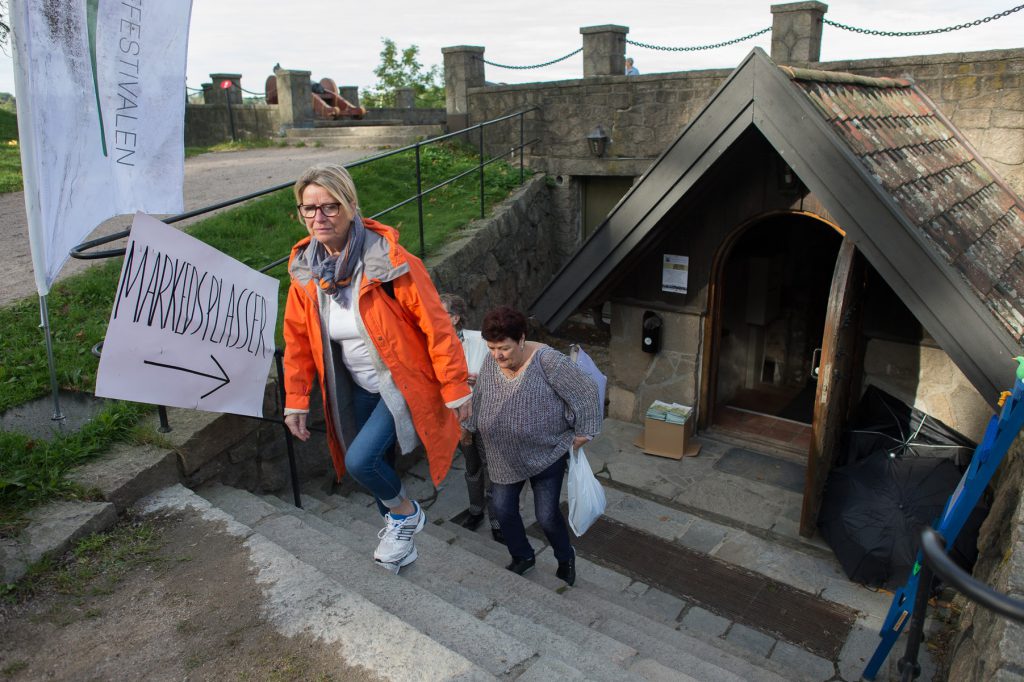 The entrance to the market hall was down these steps and they were rarely as empty as this. The festival opened on Thursday and lasted until the Saturday. On the first day there was a majority of retired knitters, while the age of the knitters seemed to decrease by decades for each day.
The entrance to the market hall was down these steps and they were rarely as empty as this. The festival opened on Thursday and lasted until the Saturday. On the first day there was a majority of retired knitters, while the age of the knitters seemed to decrease by decades for each day.
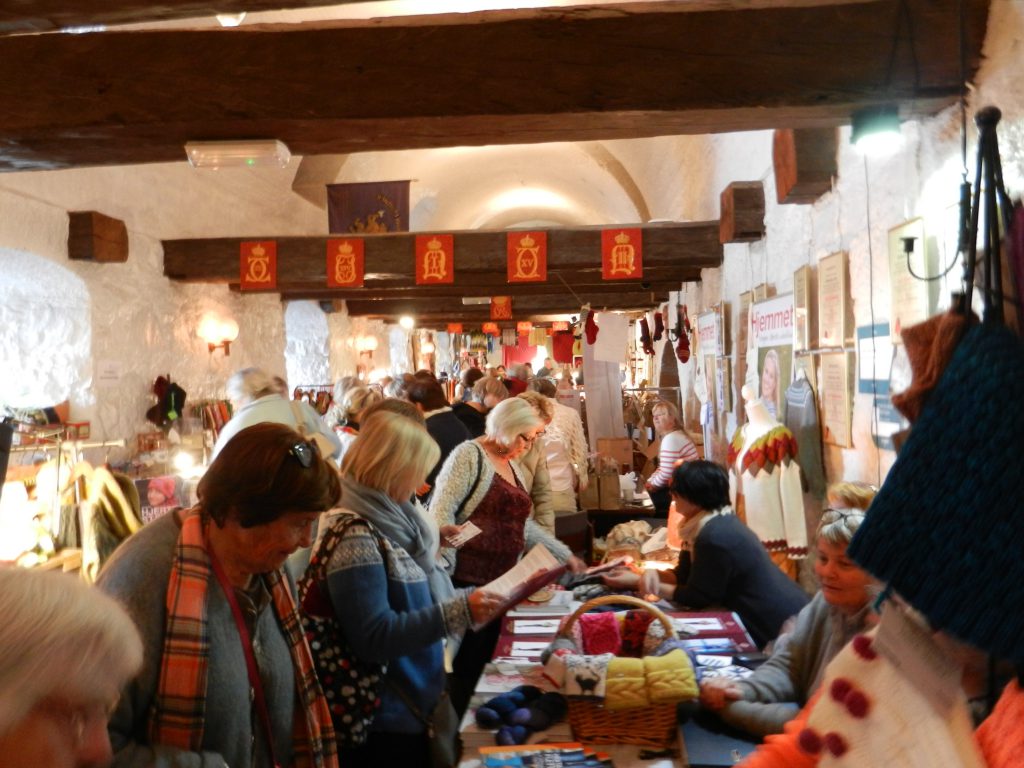 This is downstairs in the busy market hall on the Saturday. At times several of us visitors preferred to walk around the old town or visit one of the many nearby coffee shops with our knitting in hand. I was lucky to meet several knitters who knew me by name only and happy to share my table at lunch. As all knitters we do have plenty to talk about.
This is downstairs in the busy market hall on the Saturday. At times several of us visitors preferred to walk around the old town or visit one of the many nearby coffee shops with our knitting in hand. I was lucky to meet several knitters who knew me by name only and happy to share my table at lunch. As all knitters we do have plenty to talk about.
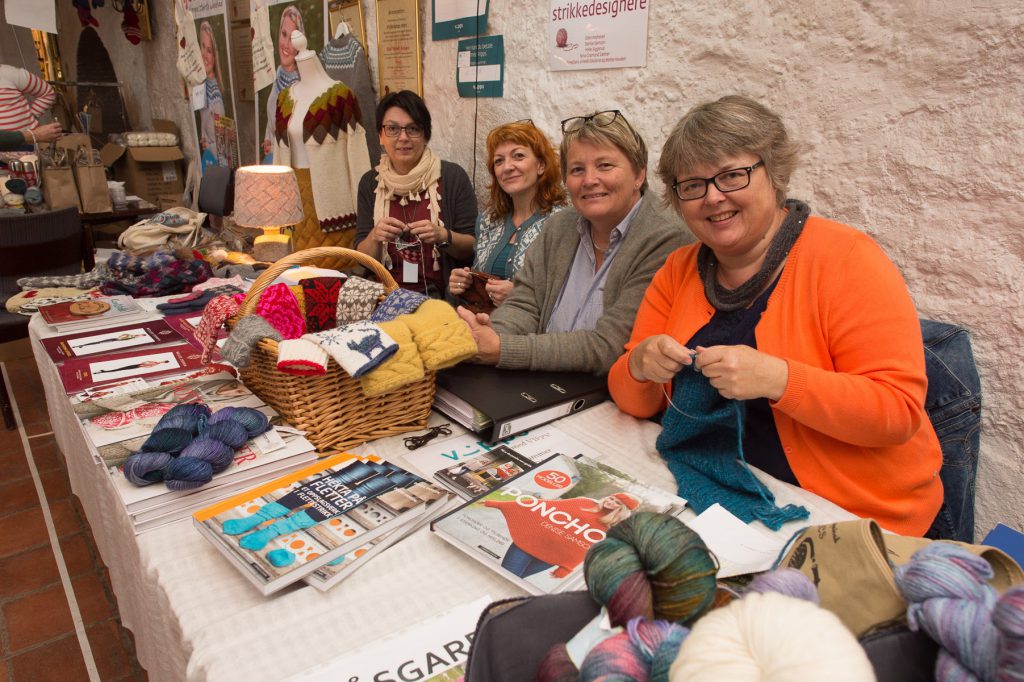 Here is the Norwegian designers stall from left: Mette Hovden – one half of the design duo Pinnedans – Helles Siggerud, Nina Granlund Sæther and Ellen Andresen. Not present in the photo is Denise Samson, but you can see her two books: Hekta på Fletter and Poncho displayed on the table.
Here is the Norwegian designers stall from left: Mette Hovden – one half of the design duo Pinnedans – Helles Siggerud, Nina Granlund Sæther and Ellen Andresen. Not present in the photo is Denise Samson, but you can see her two books: Hekta på Fletter and Poncho displayed on the table.
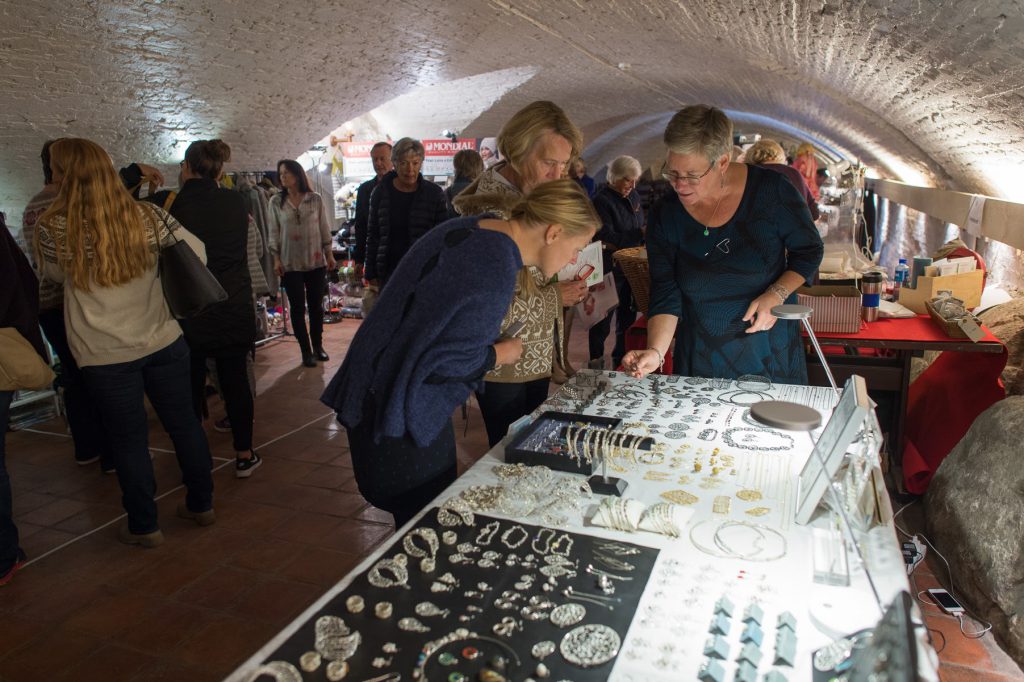 There were 21 stands in the market hall separated into two vaults next to each other. On offer in addition to hand knit designers, where yarn shops, the magazines Familien and Hjemmet both published by Egmont, the button shop Perlehuset – run by Aneta Kvist, Thomas’ mother – jewelry designers, machine knit designers, one travel agent and textiles.
There were 21 stands in the market hall separated into two vaults next to each other. On offer in addition to hand knit designers, where yarn shops, the magazines Familien and Hjemmet both published by Egmont, the button shop Perlehuset – run by Aneta Kvist, Thomas’ mother – jewelry designers, machine knit designers, one travel agent and textiles.
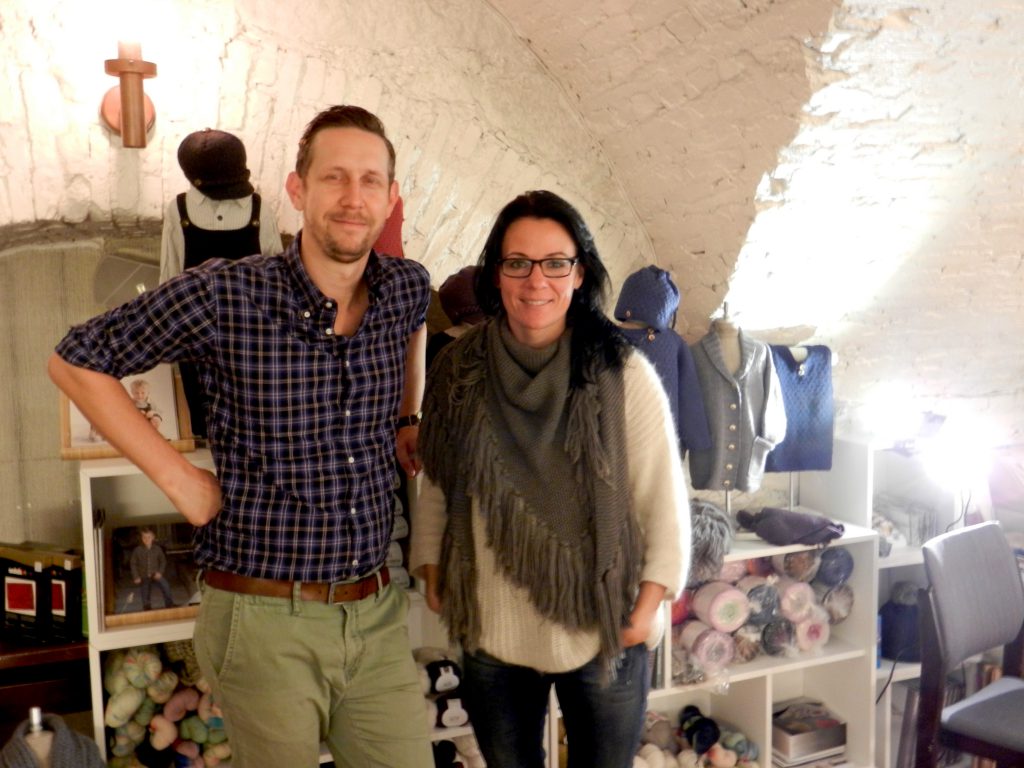 Here is a blurry photo of designer Marte Helgetun, who I met for the first time and Mondial agent Thomas Kvist (former yarn producer, now super agent) both at the Flamingo Garn og Hobby stall. Make no mistake this is one of my photos – together with the first, third and eight from the top – the remaining sharp and brilliant photos are all taken by Geir Arnesen. He is married to designer and author Tove Fevang – who usually take part in all the Norwegian knitting festivals – hence he is omnipresent too.
Here is a blurry photo of designer Marte Helgetun, who I met for the first time and Mondial agent Thomas Kvist (former yarn producer, now super agent) both at the Flamingo Garn og Hobby stall. Make no mistake this is one of my photos – together with the first, third and eight from the top – the remaining sharp and brilliant photos are all taken by Geir Arnesen. He is married to designer and author Tove Fevang – who usually take part in all the Norwegian knitting festivals – hence he is omnipresent too.
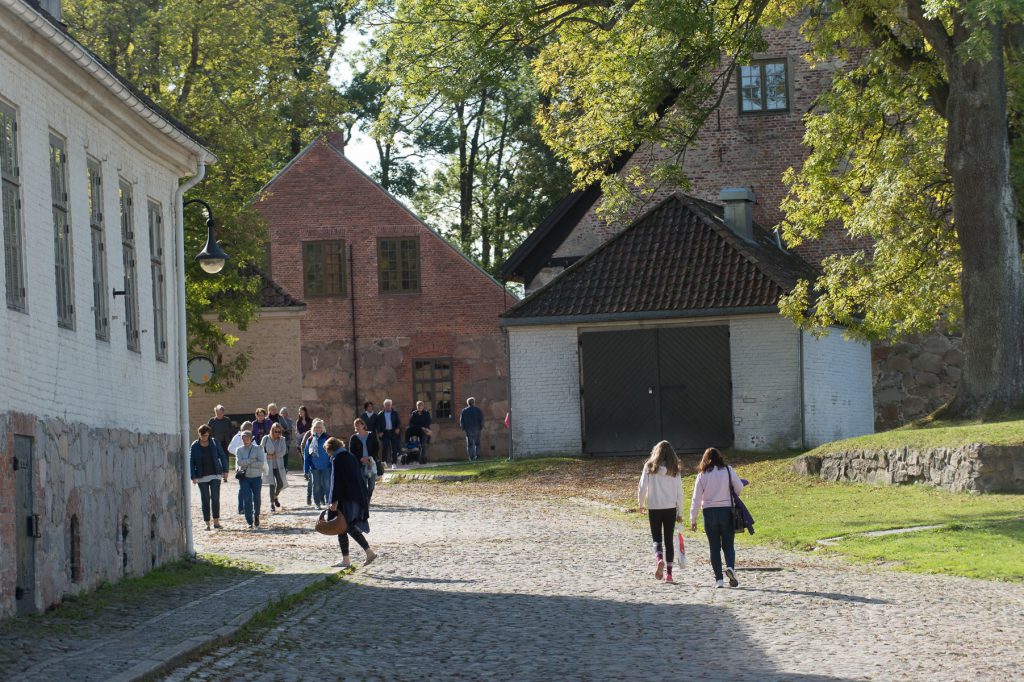 I was promoting the yarn kits made by Hillesvåg Ullvarefabrikk with my designs and spoke to shop owners, other designers I met and knitters. This time I held no workshop and was free to make up my program. I was delighted to stay with Makeløs/Remarkable designer Kristin Elise Halkjelsvik again – in charge of the Makeløs Festaften/Party evening – and to be on the guest list for the party. Her husband was the designated driver, taking runs to the market hall first me, then jewelry designer Siri Berrefjord and then to the party venue all of Saturday afternoon. Thank you, Espen! On offer were also a few exhibitions including a competition organized together with the Fredrikstad Town 450 Years Jubilee to make a Fredrikstad Pullover 2017. The winner was announced at the Makeløs Festaften, which I will write a separate post about. You can find photos and the pattern in Norwegian here: Fredrikstadgenseren 2017
I was promoting the yarn kits made by Hillesvåg Ullvarefabrikk with my designs and spoke to shop owners, other designers I met and knitters. This time I held no workshop and was free to make up my program. I was delighted to stay with Makeløs/Remarkable designer Kristin Elise Halkjelsvik again – in charge of the Makeløs Festaften/Party evening – and to be on the guest list for the party. Her husband was the designated driver, taking runs to the market hall first me, then jewelry designer Siri Berrefjord and then to the party venue all of Saturday afternoon. Thank you, Espen! On offer were also a few exhibitions including a competition organized together with the Fredrikstad Town 450 Years Jubilee to make a Fredrikstad Pullover 2017. The winner was announced at the Makeløs Festaften, which I will write a separate post about. You can find photos and the pattern in Norwegian here: Fredrikstadgenseren 2017
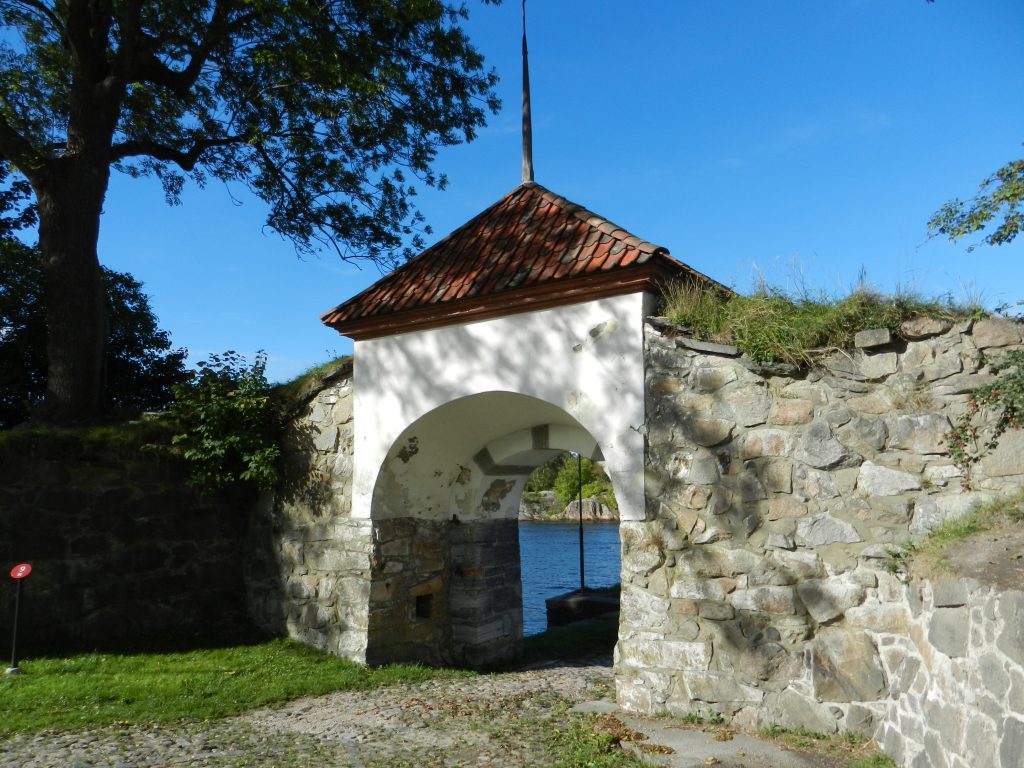 Here is one of the lovely views to be found walking around the ramparts. I was stopped a couple of times by local residents wondering what was going on, and why there were so many women around? I was happy to tell the uninitiated that there was a knitting festival on, and that the old town was invaded by knitters. One of the coffee shop owners were amazed and had never had this kind of turnover before. We were all wished welcome back with out knitting next year.
Here is one of the lovely views to be found walking around the ramparts. I was stopped a couple of times by local residents wondering what was going on, and why there were so many women around? I was happy to tell the uninitiated that there was a knitting festival on, and that the old town was invaded by knitters. One of the coffee shop owners were amazed and had never had this kind of turnover before. We were all wished welcome back with out knitting next year.
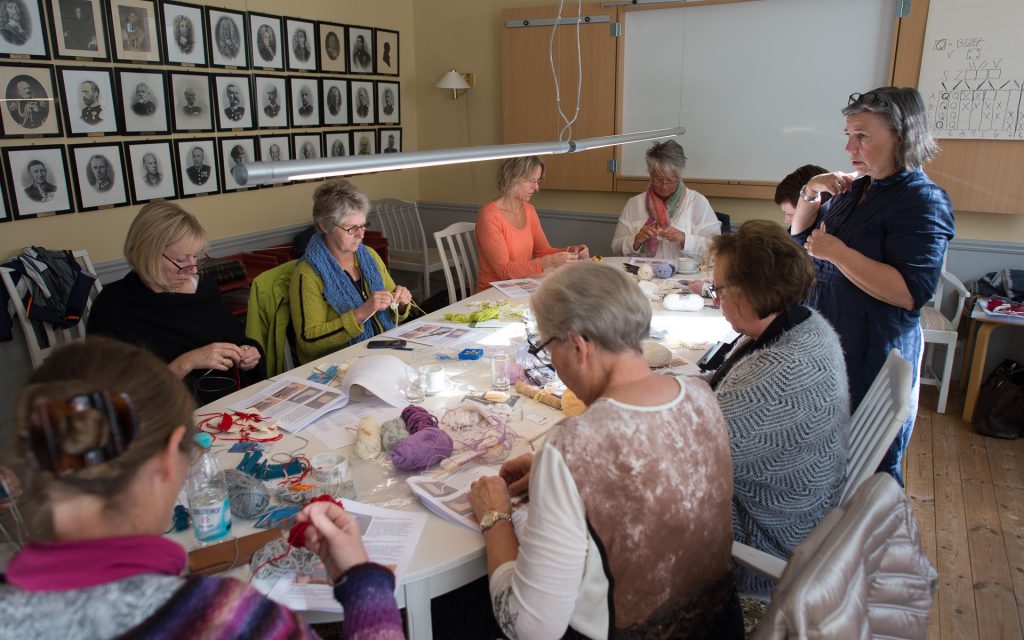 Above you see Tove Fevang teaching a workshop called: Perfekt avslutning på strikketøyet/Perfect finishing of your knitting. The first of two on the same day, due to popular demand. There were a total of 29 workshops to choose from and 11 lectures were held in a selection of historic buildings.
Above you see Tove Fevang teaching a workshop called: Perfekt avslutning på strikketøyet/Perfect finishing of your knitting. The first of two on the same day, due to popular demand. There were a total of 29 workshops to choose from and 11 lectures were held in a selection of historic buildings.
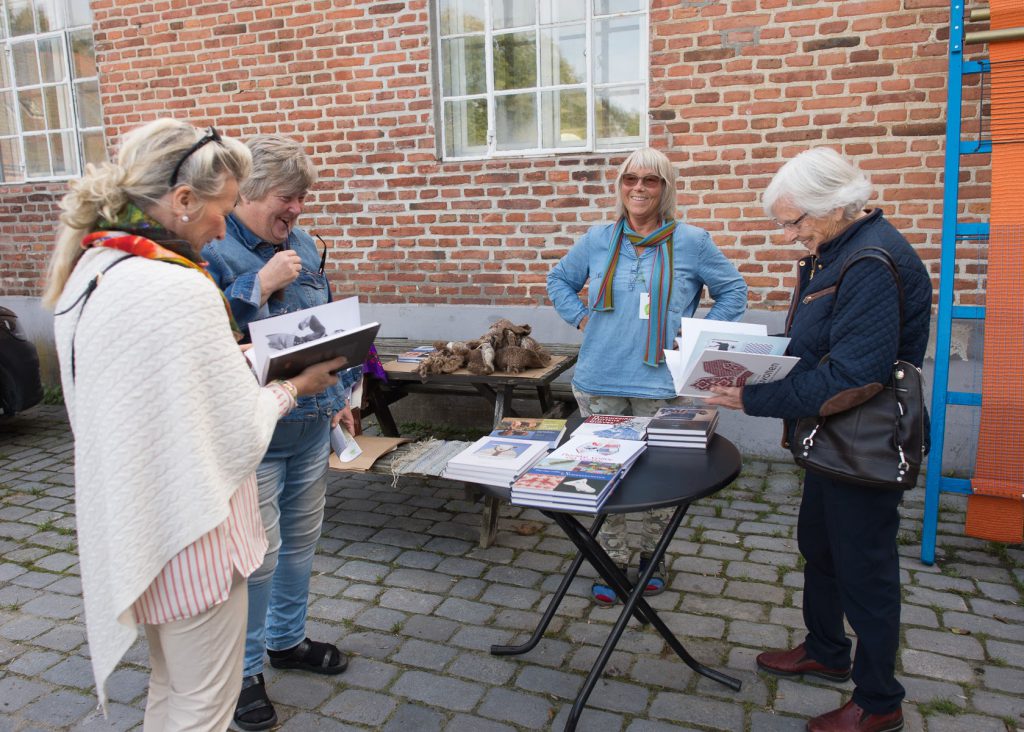 I was thrilled to be able to attend talks for once without having any workshops that made it impossible nor being too tired. On top of my list of preferences was Annemor Sundbø – the Norwegian knitting legend – with her talk: Strikkekofter med tråder fra malerpensel/Knitting cardigans with threads from the paint brush. She did not disappoint and also talked about how she came about buying a shoddy factory. Above you see her presenting her books. You will find the English ones here: annemor.com. I also choose Nina Granlund Sæther’s talk on Norske Strikketradisjoner/Norwegian Knitting Traditions. It was ever so enjoyable and inspiring to hear! A separate post on the Makeløs Festaften/Party evening is coming.
I was thrilled to be able to attend talks for once without having any workshops that made it impossible nor being too tired. On top of my list of preferences was Annemor Sundbø – the Norwegian knitting legend – with her talk: Strikkekofter med tråder fra malerpensel/Knitting cardigans with threads from the paint brush. She did not disappoint and also talked about how she came about buying a shoddy factory. Above you see her presenting her books. You will find the English ones here: annemor.com. I also choose Nina Granlund Sæther’s talk on Norske Strikketradisjoner/Norwegian Knitting Traditions. It was ever so enjoyable and inspiring to hear! A separate post on the Makeløs Festaften/Party evening is coming.
Book Launch: Votter by Nina Granlund Sæther
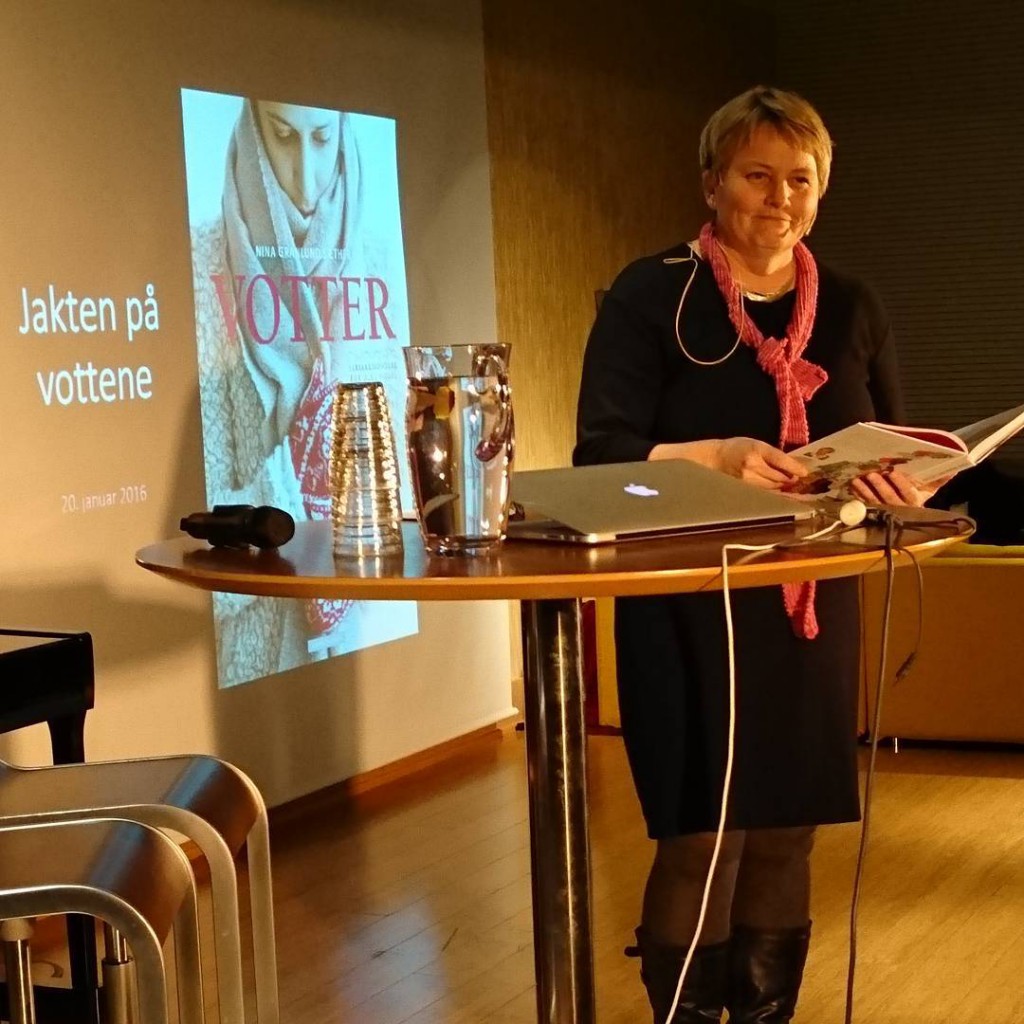 Last Wednesday I went to the book launch of Votter/Mittens by editor, journalist, hand craft teacher and acknowledged author Nina Granlund Sæther and Sitteunderlag/Mat Seat by first time author Ann-Heidrun Skår. Above you see Nina, photographed by Ellen T. Andresen aka Siso Designs, reading from her book like authors usually do but it was hilarious since she was reading from one of the 43 knitting patterns in her book. Everyone present knew knitspeak so we understood. Nina told us about her hunt for the mittens, and her visits to museums in 10 of Norway’s counties, as well as her online search. A total of 30 of the patterns are reconstructed based on historic materials while the remaining ones are her own designs. The history to the different mittens is beautifully presented in the book with brilliant photos by Guri Pfeifer. No wonder that the book is on the best seller list really. 17 500 copies are sold so far, hence the 3rd edition has just gone to print. I predict that it will be translated into English just like two of Nina’s previous books: Putefest/Cushion Party published as: Making Cushions and Pillows: 60 Cushions and Pillows to Sew, Stitch, Knit and Crochet as well as Raske Sting/Quick Stitches published as The Joy of Stitching. See Amazon.com. The publisher Cappelen Damm predicted that the knitting wave would wane, but it does not show any signs of it here in Norway.
Last Wednesday I went to the book launch of Votter/Mittens by editor, journalist, hand craft teacher and acknowledged author Nina Granlund Sæther and Sitteunderlag/Mat Seat by first time author Ann-Heidrun Skår. Above you see Nina, photographed by Ellen T. Andresen aka Siso Designs, reading from her book like authors usually do but it was hilarious since she was reading from one of the 43 knitting patterns in her book. Everyone present knew knitspeak so we understood. Nina told us about her hunt for the mittens, and her visits to museums in 10 of Norway’s counties, as well as her online search. A total of 30 of the patterns are reconstructed based on historic materials while the remaining ones are her own designs. The history to the different mittens is beautifully presented in the book with brilliant photos by Guri Pfeifer. No wonder that the book is on the best seller list really. 17 500 copies are sold so far, hence the 3rd edition has just gone to print. I predict that it will be translated into English just like two of Nina’s previous books: Putefest/Cushion Party published as: Making Cushions and Pillows: 60 Cushions and Pillows to Sew, Stitch, Knit and Crochet as well as Raske Sting/Quick Stitches published as The Joy of Stitching. See Amazon.com. The publisher Cappelen Damm predicted that the knitting wave would wane, but it does not show any signs of it here in Norway.
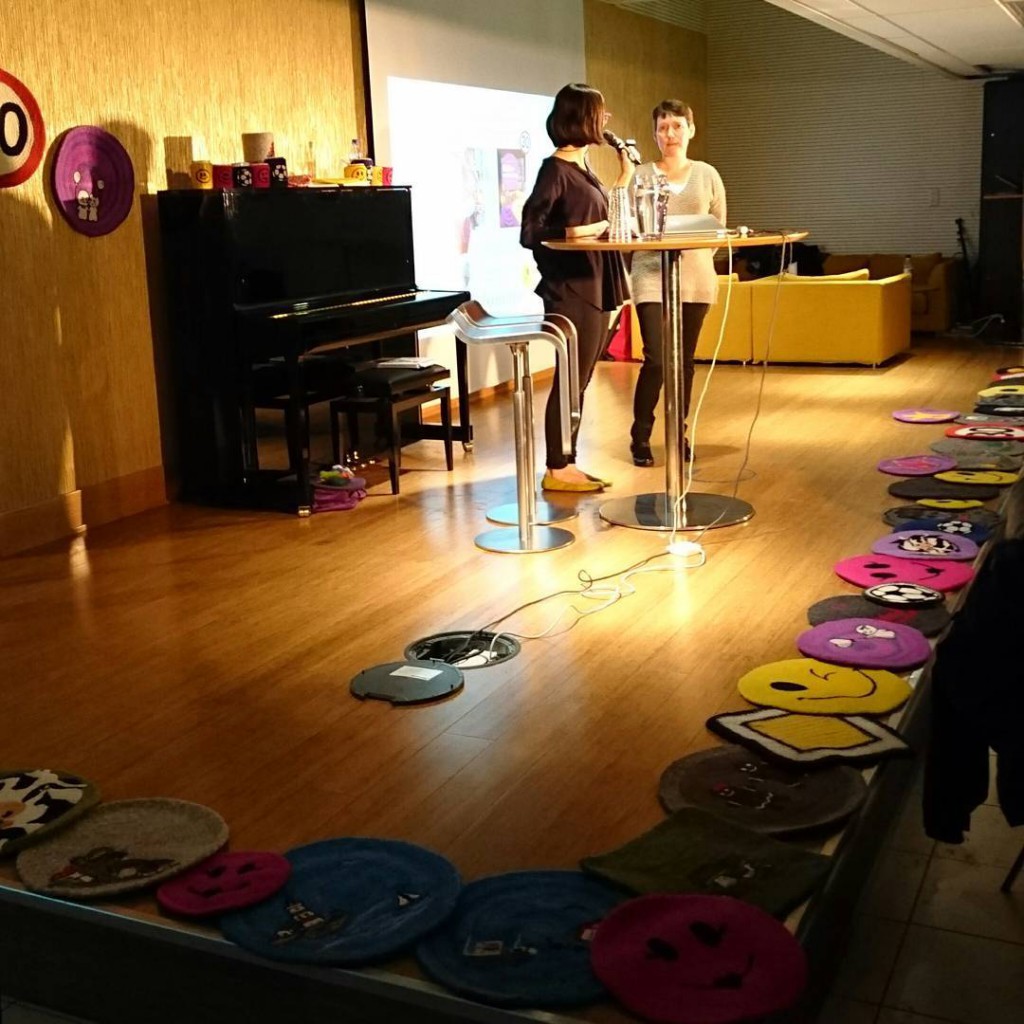 Ann-Heidrun Skår’s book about how to needle felt and crochet then felt Sitteunderlag/Mat Seat has just hit the book stores. Editor Kaja Marie Lereng Kvernbakken asked her about her inspiration and she told us how her family had assisted in the drawing process. A number of knitters, we were told did not want to use the mats as mat seats but used them instead as table mats. In the photo above, also photographed by Ellen T. Andresen, you see a large selection of her mat seats. Do read, with or without the aid of Google translate, Kaja Marie’s reply to what a knitter is at forlagsliv.no.
Ann-Heidrun Skår’s book about how to needle felt and crochet then felt Sitteunderlag/Mat Seat has just hit the book stores. Editor Kaja Marie Lereng Kvernbakken asked her about her inspiration and she told us how her family had assisted in the drawing process. A number of knitters, we were told did not want to use the mats as mat seats but used them instead as table mats. In the photo above, also photographed by Ellen T. Andresen, you see a large selection of her mat seats. Do read, with or without the aid of Google translate, Kaja Marie’s reply to what a knitter is at forlagsliv.no.
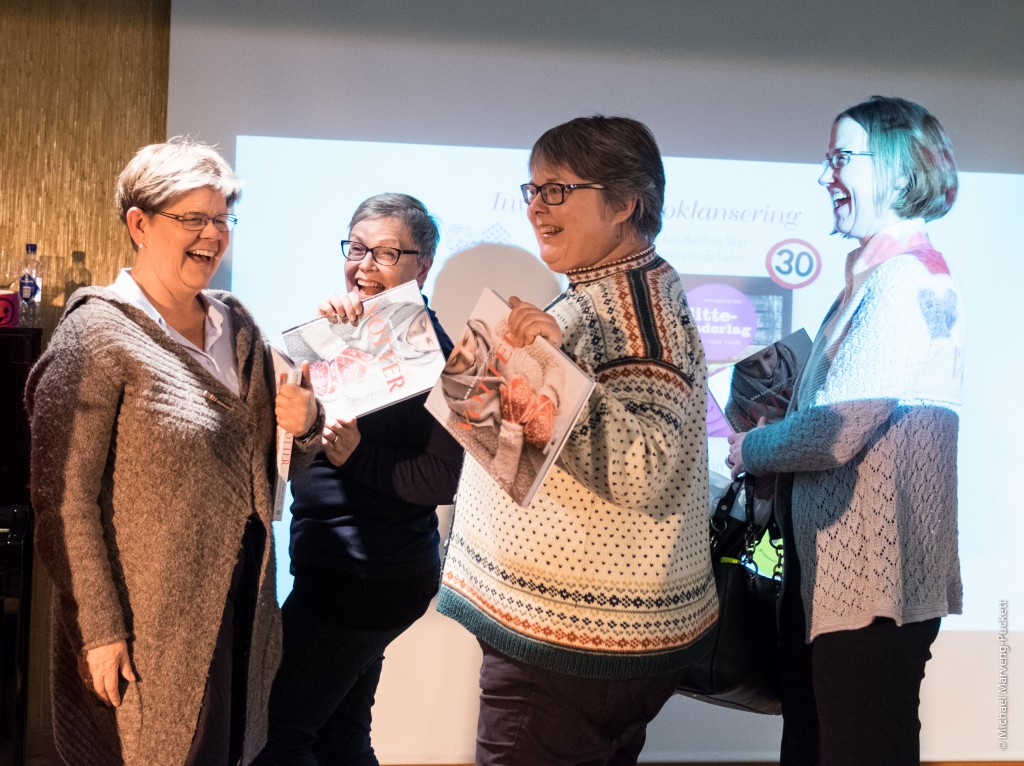 There were a number of us fellow designers that wanted to attend Nina’s launch and many of us queued up so that Nina could sign our newly bought copies. We were chatting away at the end of the queue. Some had to leave to prepare their own upcoming book launch like: Vanja Blix Langsrud, see the cover on her & Tone Loeng’s book Koftefest. Vanja is also selling her own knitting calendar here: vanjastrikk.no. From left in the photo above, taken by my husband, is designer and translator Denise Samson and her friend & knitter Mona Helén Rønningsen, designer Ellen T. Andresen in a bought kofte and me wearing Sarya. Denise was just telling us about her hectic period before Christmas and her new book coming in April. The knitting wave definitely continues here in Norway.
There were a number of us fellow designers that wanted to attend Nina’s launch and many of us queued up so that Nina could sign our newly bought copies. We were chatting away at the end of the queue. Some had to leave to prepare their own upcoming book launch like: Vanja Blix Langsrud, see the cover on her & Tone Loeng’s book Koftefest. Vanja is also selling her own knitting calendar here: vanjastrikk.no. From left in the photo above, taken by my husband, is designer and translator Denise Samson and her friend & knitter Mona Helén Rønningsen, designer Ellen T. Andresen in a bought kofte and me wearing Sarya. Denise was just telling us about her hectic period before Christmas and her new book coming in April. The knitting wave definitely continues here in Norway.
The Knitting Wave or Why Yarns Pill Debate
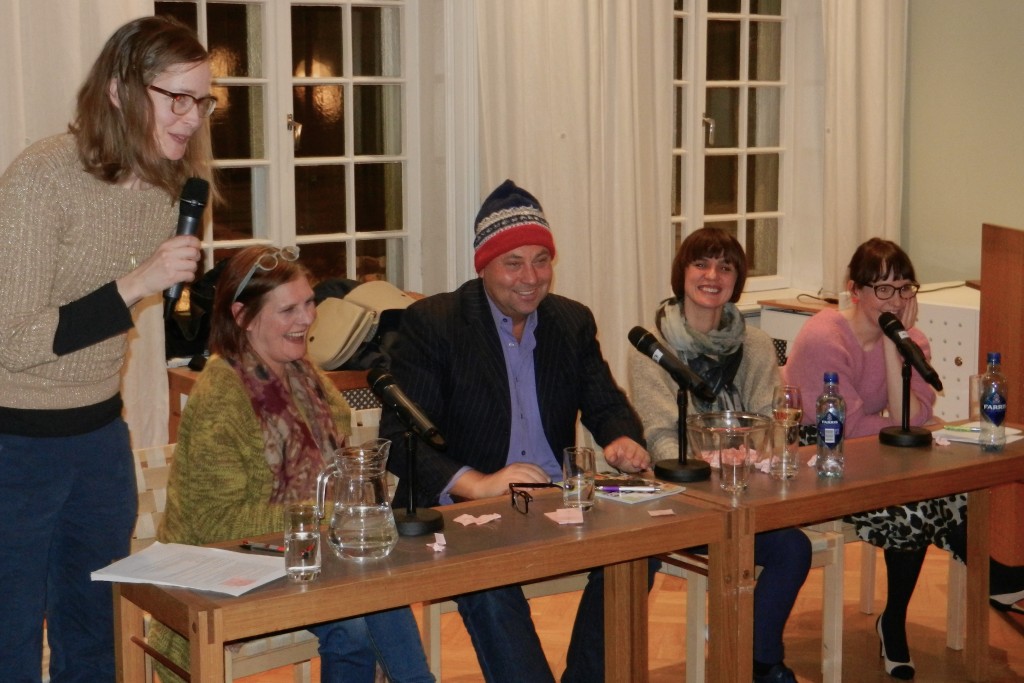 The topic of the debate organized by NFF, Norsk faglitterær forfatter og oversetter forening/Norwegian Non-fiction Writers And Translators Association was; What makes a knitting book successful, and what started the current knitting wave in Norway? The evening started with nearly a 100 attendees – a mixture of authors, journalists, reporters, knitters and other interested persons – facing a panel consisting of Pickles founders: Anna Enge and Heidi Grønvold, publisher MD Arve Juritzen of Marius Strikkebok (85 000 copies sold, see my post Craft Wave), author Kristin Wiola Ødegard, and chaired by Kristin Isaksen communications leader at NFF. First, the panel introduced themselves, and told us what they believed to be the future of the knitting book. The Pickles’ girls were surprised that their 3 books containing patterns, all previously published online, still sold like hotcakes and believed knitters wanted their patterns gathered in print form – a bit like the way a squirrel hoards or stash – and that the knitting wave is a revenge of the knitting nerd. You could hear the collective nod, since we all have a stash of yarns and books. In addition, knitting is now accepted in public spaces, formerly unheard of. Juritzen was taken back by the Marius book success, but believed it to be due to its storytelling ability, and told us that they now receive about 2 new knitting book proposals a week. Juritzen himself is convinced that a knitting book should be summed up in one sentence for it to have a chance of a success. Kristin’s book explains itself in the title, strikes a blow for the use of waste yarn, and was inspired by her customers’ demand at the yarn shop, Tjorven but is not published by Juritzen but by Gyldendal.
The topic of the debate organized by NFF, Norsk faglitterær forfatter og oversetter forening/Norwegian Non-fiction Writers And Translators Association was; What makes a knitting book successful, and what started the current knitting wave in Norway? The evening started with nearly a 100 attendees – a mixture of authors, journalists, reporters, knitters and other interested persons – facing a panel consisting of Pickles founders: Anna Enge and Heidi Grønvold, publisher MD Arve Juritzen of Marius Strikkebok (85 000 copies sold, see my post Craft Wave), author Kristin Wiola Ødegard, and chaired by Kristin Isaksen communications leader at NFF. First, the panel introduced themselves, and told us what they believed to be the future of the knitting book. The Pickles’ girls were surprised that their 3 books containing patterns, all previously published online, still sold like hotcakes and believed knitters wanted their patterns gathered in print form – a bit like the way a squirrel hoards or stash – and that the knitting wave is a revenge of the knitting nerd. You could hear the collective nod, since we all have a stash of yarns and books. In addition, knitting is now accepted in public spaces, formerly unheard of. Juritzen was taken back by the Marius book success, but believed it to be due to its storytelling ability, and told us that they now receive about 2 new knitting book proposals a week. Juritzen himself is convinced that a knitting book should be summed up in one sentence for it to have a chance of a success. Kristin’s book explains itself in the title, strikes a blow for the use of waste yarn, and was inspired by her customers’ demand at the yarn shop, Tjorven but is not published by Juritzen but by Gyldendal.
Second, after the interval, the knitting needles were still going strong, it was our turn to join the debate and ask questions. Researcher Ingunn Grimstad Klepp from Sifo, author of Ren Ull/Pure Wool, pointed out that the Knitting Wave did not start in Norway but that we were merely on the edge of it, and that it originated in the US or the UK. The opinions varied to why it occurred, but the Financial crisis; the creative urge that has arisen; the knitting society that the social media have helped to build; knitting’s ability to remove restlessness and to reclaim time, as well as how relaxing it is were some that were mentioned.
The debate sidetracked when the questions if yarn customers ask where the yarn is produced, and how it behaves were raised. Suddenly, we reached a why yarns pill debate, where the opinions differed especially on how much the person wearing it mattered – friction – but most agreed that it is due to the mixed fiber content (usually with man-made fibres), the degree of twist, short staple fibres, and loose knitting.
What is the next knitting hit going to be, asked Juritzen. No one had a clear answer but casual top-down kofter/traditional jackets was one of the suggestions. Designer and journalist – as well as Editor-in-chief – Nina Grønlund Sæther pointed out that designer Tove Fevang with more than 400 000 sold crafts books would be the right person to ask since she was present. Tove told us that her two latest books on childrens wear based on classic patterns had been successful. As for the next hit, she believes in the necessity of adding finishing techniques to her books since we can no longer rely on the transferring of skills between the generations. Grandmother will not always be around to take over the finishing process of a garment. In the photo above is Nina in the front, next to Denise Samson – designer and translator – Tove Fevang and me at the end (read: I did not know if I would fit into the photo).
Beautiful photos are important to attract the knitters, Kristin pointed out and Juritzen agreed. He had been surprised of the casual approach to this only a few decades back. Designer, blogger and podcaster Ann Myhre – aka Pinneguri/The Needle Lady – pointed out that with Ravelry and the free access to knitters’ own photos to link to the pattern page, that photos on single patterns did not necessarily need to be stunning. Ann’s own success with the Sinnasau/Where-the-wild-sheep-roam pattern proves her point. Just take a look at all the different versions of the jacket. Here is Ann’s summing up of the evening: nuppedebatten.
A reporter from the Norwegian State Broadcaster was present and could reveal that there will be yet another slow television program – see slow-tv-norwegian-movement-nrk – related to knitting this autumn. It will focus on hobbies and craft. We are waiting in anticipation, and comments flew in the audience that the level must be higher than on the previous program. Third, there was a book draw donated by the panel, and 7 happy winners were found. One of them, believed in giving something back, and donated a knitted Marius hat to Juritzen and you can see his happy face in the top photo.
It certainly was a heated debate at times, and it took turns we had not anticipated. Several of us would have liked to have seen Cappelen Damm, the largest of the Norwegian craft book publishers present in the panel, and a stricter chairman, but what a crowd, NFF had managed to attract. Finally, we were encouraged to send book proposals to Juritzen – yes, preferably to be summed up in a sentence – and to apply for grants at NFF. Here is the review, and a recording in Norwegian, with very low sound, from NFF: Strikkedilla.
The Day Job: Made By Me
The latest issue of Made By Me came out on Monday, here in Norway. I have not submitted any designs, but I have written some of the picture texts, translated a number of the patterns from English into Norwegian, and formatted a number of the patterns. That is one part of my day job, the other much larger part is the translation of the previous issues of Made By Me – 3 in total – into English for both the UK and the US market where it will be sold as an app. The popular magazine covers Knitting, Crocheting, Sewing and Crafts and the latest issue contains a whopping 92 patterns, printed in a separate booklet. I love reading the designer portraits, the trend reports as well as studying the designs!
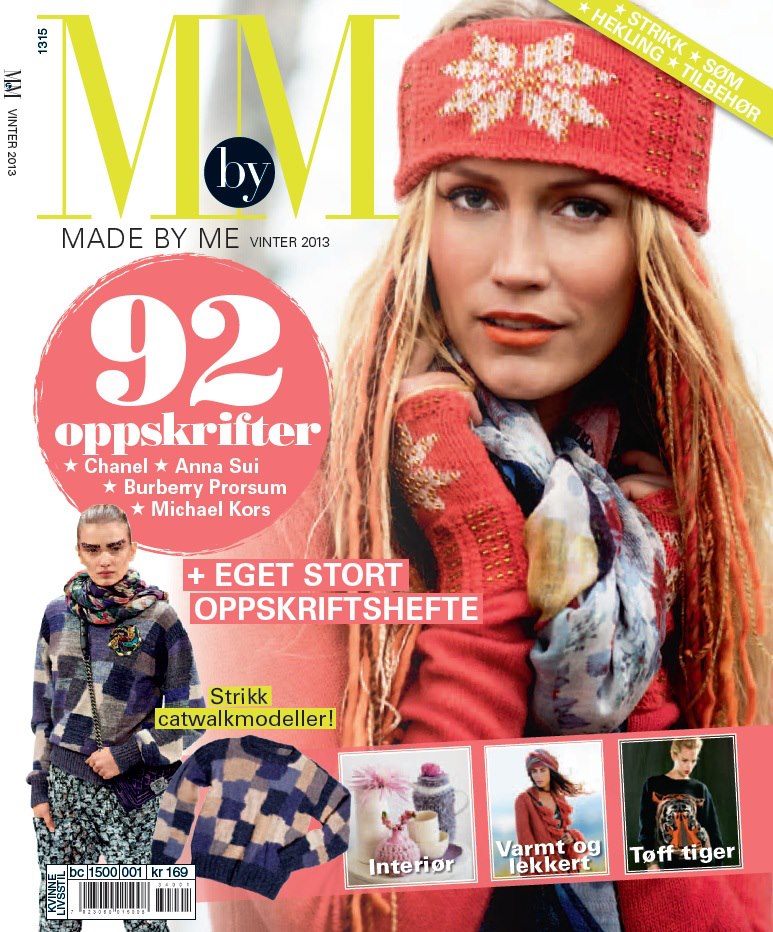 My favorite designs in this issue are by acknowledged Norwegian designers Ann-Kristin Knardal: an Inca inspired series of garments in alpaca – see below, Sidsel Høivik: an elegant outfit in layers with a matching bag decorated with buttons – see button set: knappesett, and Nina Granlund Sæther whose book: Putefest is presented with 2 patterns, read my post: putefestcushion-party. The formerly bi-annual now quarterly magazine is published by Egmont Hjemmet Mortensen, designer is Tine Solheim, see tinesolheim – I am listed under Diagram og Oversetting/Chart and Translation, since you ask – and it has a Swedish version. Its conquest continues…
My favorite designs in this issue are by acknowledged Norwegian designers Ann-Kristin Knardal: an Inca inspired series of garments in alpaca – see below, Sidsel Høivik: an elegant outfit in layers with a matching bag decorated with buttons – see button set: knappesett, and Nina Granlund Sæther whose book: Putefest is presented with 2 patterns, read my post: putefestcushion-party. The formerly bi-annual now quarterly magazine is published by Egmont Hjemmet Mortensen, designer is Tine Solheim, see tinesolheim – I am listed under Diagram og Oversetting/Chart and Translation, since you ask – and it has a Swedish version. Its conquest continues…
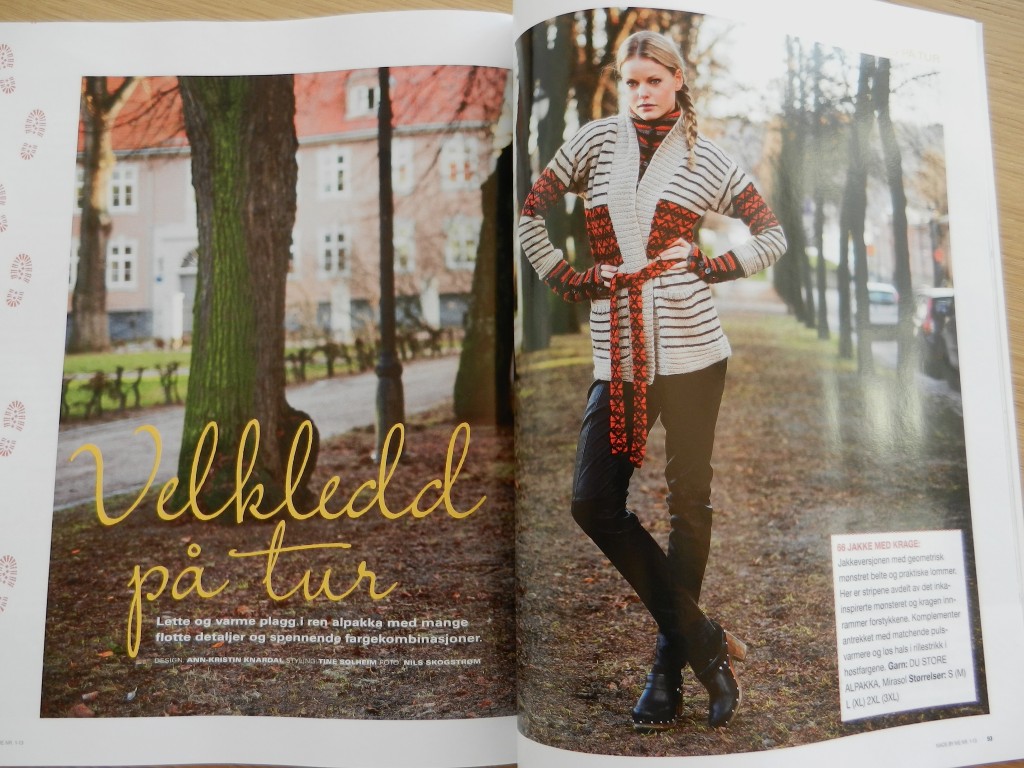 Design Update: I am pleased to let you know that Clotheshorse has accepted my design submission for their Fall/Winter 2013 issue!
Design Update: I am pleased to let you know that Clotheshorse has accepted my design submission for their Fall/Winter 2013 issue!

